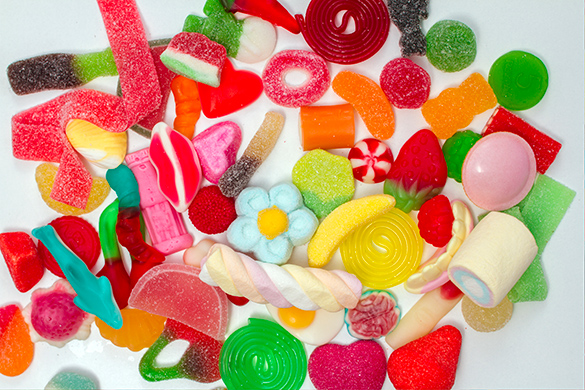Minds On
Investigating number relationships
Explore the following images and numbers. Where have you encountered numbers represented in this way? Are there relationships between any images and numbers?

Action
Coloured candy
Mr. Patel’s grade 7 students are convinced that candy factories don’t fill the candy packages with an equal number of each flavoured candy.
Three quarters of the class is convinced that the most common colour of candy comes in red (stars), orange (hearts) and yellow (quarter moons). The rest of the class thinks the common colours are blue (clovers), green (squares) and purple (diamonds).
The class decides to open a package and record their findings. The bag had a total of 26 candies. The colours were recorded in a chart. Find the fractions, decimals, and percents of each colour to support their findings.

Press the ‘Activity’ button to access Candy Colour Chart.
| Candy colour /26 | Fraction | Decimal | Percent |
|---|---|---|---|
| Red (stars) 2 | |||
| Orange (hearts) 4 | |||
| Yellow (quarter moons) 2 | |||
| Green (squares) 6 | |||
| Blue (clovers) 7 | |||
| Purple (diamonds) 5 |
Work with a partner, if possible, to answer the following questions or record your responses in a method of your choice.
- Which candy colour was the most popular?
- Which group was correct about the most common colours?
- How are totals easier to compare? Using fractions, decimals or percent? Explain.
- What happens when you add up all the decimals? What happens when you add up the percents?
- If the class opened a second package of candy, do you think their totals would be the same? Why or why not?
Be prepared to share your thinking in a recording, journal or with a partner.
Consolidation
Candy shop sales
The school athletic club opened a candy shop to raise money to buy new team uniforms. They sell a variety of candy snacks at a range of prices.
The students that run the candy shop chose their favourite items to sell. The following picture lists the snacks for sale and the price for each snack.
The sales for the past week are recorded in a chart. The values listed represent the portion of each item sold. Help complete the table by filling in the missing fractions, decimals, and percents.
Press the ‘Activity’ button to access Candy Shop Prices.
| CANDY | FRACTION | DECIMAL | PERCENT |
|---|---|---|---|
| Licorice | 0.1 | ||
| Chocolate bars | |||
| Lollipops | 9% | ||
| Gummy candy | |||
| Gum | 15% | ||
| Candy popcorn | 0.01 | ||
| Sour candy | |||
| Mint candy | |||
| Chocolate almonds | 0.0 | ||
| Marshmallow puff | 0.65 |
Choose 2 of the questions to respond to about this work.
- Which candy item should be ordered more often?
- Which are the top three sellers?
- Should they consider replacing one of the items with something different? Which one do you think?
- Which item brings in the most money?
- Does the data tell you how many people stop by the candy shop each day? Or if they make more than one purchase at a time?
- Write three statements describing data collected in the table.
Reflection
As you read the following descriptions, select the one that best describes your current understanding of the learning in this activity. Press the corresponding button once you have made your choice.
I feel...
Now, expand on your ideas by recording your thoughts using a voice recorder, speech-to-text, or writing tool.
When you review your notes on this learning activity later, reflect on whether you would select a different description based on your further review of the material in this learning activity.
Discover MoreConnect with a TVO Mathify tutor
Think of TVO Mathify as your own personalized math coach, here to support your learning at home. Press ‘TVO Mathify’ to connect with an Ontario Certified Teacher math tutor of your choice. You will need a TVO Mathify login to access this resource.
TVO Mathify (Opens in new window)